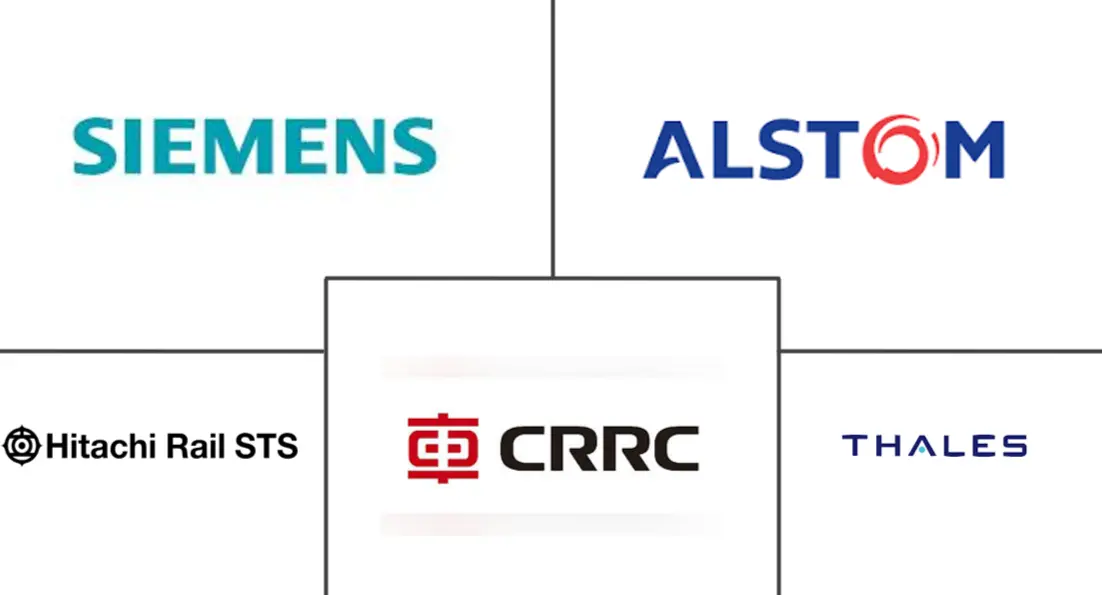Autonomous Train Market Size and Share
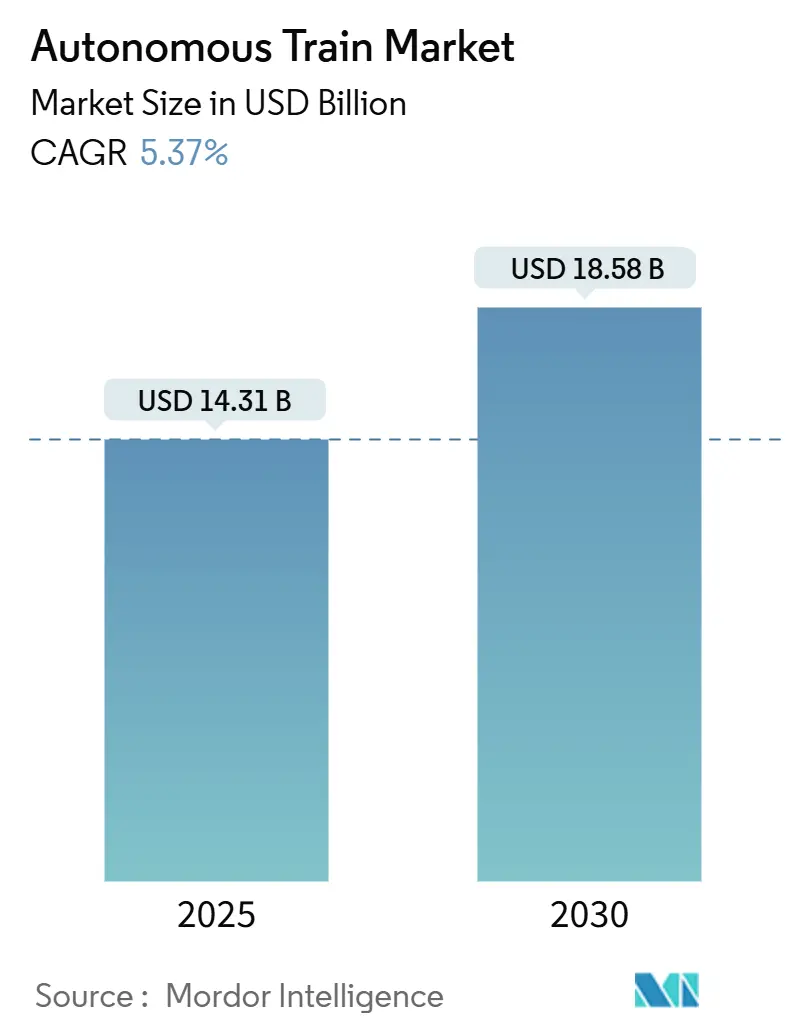
Autonomous Train Market Analysis by Mordor Intelligence
The Autonomous Train Market size is estimated at USD 14.31 billion in 2025, and is expected to reach USD 18.58 billion by 2030, at a CAGR of 5.37% during the forecast period (2025-2030). The present growth path shows a shift from proof-of-concept lines toward full-scale commercial fleets powered by Grade-of-Automation 4 platforms. Freight automation is advancing fastest as operators counter driver shortages, while passenger systems still account for three-fifth of 2024 revenue. Rapid 5G-enabled CBTC rollouts, rising sustainability mandates, and sovereign infrastructure programs in Asia-Pacific and the Middle East keep procurement pipelines robust. At the same time, cybersecurity and legacy-system interoperability remain primary deployment bottlenecks, tempering near-term expansion pace but stimulating demand for certified turnkey solutions. Intensifying platform consolidation, illustrated by Siemens Mobility’s multi-billion-euro Deutsche Bahn framework, reinforces scale advantages for incumbents even as venture-backed disruptors secure strategic footholds.
Key Report Takeaways
- By automation grade, GoA 2 retained 53.27% of the Autonomous Train market share in 2024, while GoA 4 is projected to deliver a 5.41% CAGR through 2030.
- By application, passenger services led with 61.28% of the Autonomous Train market revenue share in 2024; freight services are expected to expand at a 5.45% CAGR between 2025 to 2030.
- By technology, conventional CBTC captured 46.73% of the Autonomous Train market size in 2024, whereas 5G-ready CBTC lines are forecast to post the segment’s highest 5.48% CAGR to 2030.
- By train type, metro and monorail systems held 45.52% of the Autonomous Train market size in 2024 deployments; high-speed rail automation shows the fastest 5.52% CAGR to 2030.
- By geography, Asia-Pacific commanded 38.62% of the Autonomous Train market size in 2024, while the Middle East and Africa are poised to be the quickest risers with a 5.43% CAGR over the forecast horizon.
Global Autonomous Train Market Trends and Insights
Drivers Impact Analysis
| Driver | (~) % Impact on CAGR Forecast | Geographic Relevance | Impact Timeline |
|---|---|---|---|
| Capacity Constraints Driving Automation | +1.5% | Asia-Pacific core, spill-over to Europe and North America | Short term (≤ 2 years) |
| Increased Focus On Safety | +1.2% | Global, with early adoption in Europe and Asia-Pacific | Medium term (2-4 years) |
| Rising Labor Shortages | +1.1% | North America and Europe, emerging in Asia-Pacific | Medium term (2-4 years) |
| 5G & Edge Computing | +0.9% | Asia-Pacific and Europe, gradual adoption in North America | Medium term (2-4 years) |
| Energy Efficiency | +0.8% | Europe and North America, expanding to Asia-Pacific | Long term (≥ 4 years) |
| Defense Logistics Applications | +0.3% | North America and Europe, limited scope | Long term (≥ 4 years) |
| Source: Mordor Intelligence | |||
Capacity Constraints Driving Automation In Urban Metro Lines
Urban transit corridors face peak-hour saturation that infrastructure expansions alone cannot relieve. Delhi Metro’s Pink Line showcases how Unattended Train Operations shorten headways from 120 seconds to 90 seconds, equating to a 25% capacity uplift without adding rolling stock[1]Delhi Metro Rail Corporation, “Pink Line UTO Transition Press Note,” delhimetrorail.com . Crowd-flow modeling finds that synchronizing turnstile throughput with automated dwell-time management can compress station stops by one-tenth, compounding fleet-wide throughput gains. Shanghai’s 66 UTO lines validate scale economics; domestic supplier CASCO Signal now claims more than two-fifth of its national share, demonstrating local platform maturity. With urban populations growing, automation becomes the default strategy for transit authorities seeking sustainable throughput improvements under constrained capital budgets.
Increased Focus On Safety
High-profile automation programs position safety as the prime adoption trigger, with Rio Tinto’s AutoHaul heavy-haul network logging slightly speed gains while maintaining zero fatalities across 1,700 kilometers[2]Rio Tinto, “AutoHaul Milestone Update 2024,” riotinto.com . Three derailments in 2024, however, prompted new regulatory tests by Australia’s Office of the National Rail Safety Regulator, underscoring the paradox of statistical safety improvements amid novel failure modes. Commercial insurers now demand real-time performance data before underwriting large unattended-train fleets, spurring investment in advanced obstacle-detection suites that fuse lidar, radar, and machine-vision outputs at edge nodes. Passenger systems feel the greatest public-perception pressure, making demonstrable risk reduction mandatory for farebox recovery.
Rising Labor Shortages & Union Pressures
Freight carriers contend with aging engineer cohorts and high attrition, pushing automation from pilot to production. The Federal Railroad Administration’s clearance for Parallel Systems’ crewless battery-electric pilot in Georgia marks a policy shift toward acceptance despite objections from the Brotherhood of Locomotive Engineers and Trainmen. Operators project crew-requirement cuts of up to half, redirecting human resources to remote supervision and maintenance. Unions negotiate reskilling packages rather than blanket opposition, signaling an evolving social contract. Persistent labor gaps and wage inflation at 2024 levels accelerate return-on-investment models for unattended freight consists.
5G & Edge Computing For Real-Time Remote Train Ops
The union of 5G links and edge processing delivers sub-10-millisecond latencies that permit split-second command loops. Hitachi Rail’s 5G-CBTC trials on New York’s Crosstown Line demonstrate quarter bandwidth headroom above current CBTC throughput, enabling high-resolution video feeds for continuous obstacle verification. Edge-hosted digital twins generate predictive-maintenance alerts up to 72 hours before component failure, lowering unscheduled downtime by 18%. Though North America trails Asia-Pacific deployments due to spectrum-allocation obstacles, incremental upgrades to existing CBTC infrastructure help spread capex over longer horizons.
Restraints Impact Analysis
| Restraint | (~) % Impact on CAGR Forecast | Geographic Relevance | Impact Timeline |
|---|---|---|---|
| High Initial Investment | -1.8% | Global, with higher impact in emerging markets | Short term (≤ 2 years) |
| Legacy Signaling & Inter-Operability | -0.9% | Europe and North America, with spillover to Asia-Pacific | Medium term (2-4 years) |
| Cyber-Security Vulnerabilities | -0.7% | Global, with critical focus in developed markets | Medium term (2-4 years) |
| Public Acceptance & Regulatory Ambiguity | -0.6% | Global, with higher impact in developed markets | Long term (≥ 4 years) |
| Source: Mordor Intelligence | |||
High Initial Investment In New Projects
Positive Train Control outlays illustrate capex magnitude for safety-critical autonomy in the United States. Retrofit efforts often double per-kilometer costs as bespoke interfaces bridge vintage relays with Ethernet backbones, burdening commuter railroads whose PTC upkeep already absorbs up to one-fifth of yearly capital plans. Framework-contract models—such as Deutsche Bahn’s Digital Rail bundle—spread R&D and tooling costs over multiyear call-offs, lowering per-unit barriers for participating vendors. Despite emerging pay-per-passenger service models, smaller operators still struggle to access affordable financing for first-wave deployments, keeping adoption uneven across market tiers.
Cyber-Security Vulnerabilities In Connected Rail
ERTMS GSM-R channels expose attack vectors for spoofed movement authorities, and the shift toward FRMCS packet services increases packet-routing complexity. The European Union Agency for Railways flags authentication loopholes that could let threat actors inject incorrect speed profiles, forcing rail undertakings to layer IEC 62443-compatible intrusion-detection systems across vital networks. CENELEC TS 50701 demands harmonization with EN 50126 safety doctrine, challenging suppliers to satisfy dual compliance without inflating bill of materials. Cyber-hardening inflates procurement costs and extends certification cycles, moderating deployment tempo through 2029 even as vendors iterate toward standardized security-by-design platforms.
Segment Analysis
By Automation Grade: From GoA 2 Dominance to GoA 4 Momentum
GoA 2 supervised automation represented 53.27% of the Autonomous Train market size in 2024, reflecting regulator comfort with attended cabs while still reaping interval-cutting benefits. This segment anchors core revenue for platform suppliers as railroads pursue incremental upgrades that preserve current staffing patterns. Yet the Autonomous Train market size for GoA 4 platforms is predicted to widen markedly, buoyed by a 5.41% CAGR through 2030 as urban metros like Copenhagen’s S-bane shift entire networks to unattended operations. Transitional GoA 3 lines act as real-world sandboxes, validating obstacle-detection algorithms and refining remote-control protocols under human oversight.
The Autonomous Train market places fresher capital on GoA 4 because it unlocks maximum labor savings and timetable flexibility. Shanghai Metro Line 15’s 42.3-kilometer GoA 4 corridor, running TRANAVI Qiji TACS software, clocks 26-second station stops, underscoring performance payoffs. While GoA 1 and GoA 0 maintain presence in branch lines where cost-benefit math dissuades full automation, carriers increasingly schedule upgrade windows aligned with signal-renewal cycles. Suppliers fine-tune modular packages, easing leap-frog transitions for networks that once viewed GoA 4 as aspirational.
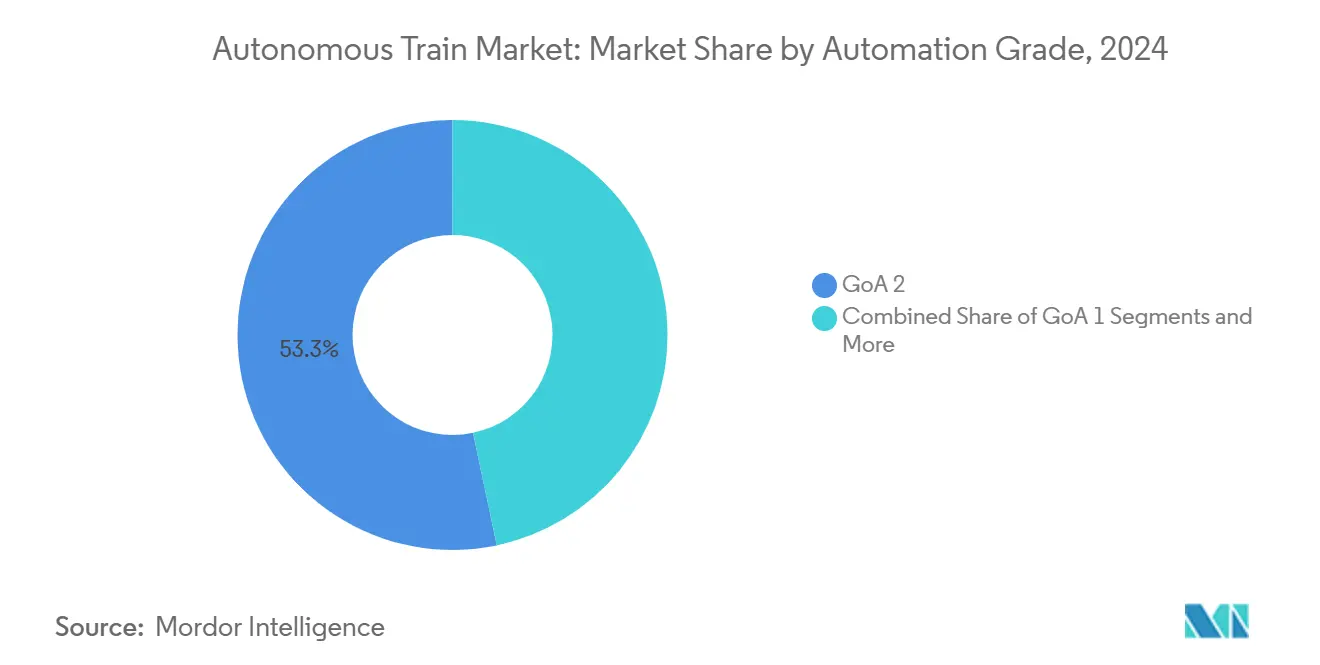
Note: Segment shares of all individual segments available upon report purchase
By Application: Freight Upswing Inside Passenger-Led Revenues
Passenger services maintained a dominant 61.28% Autonomous Train market share in 2024, benefiting from metro and commuter-rail additions across Asia-Pacific megacities. Urban transit champions automation for predictable headways, proof-pointing reliability that earns public trust. In contrast, the freight sub-segment, though smaller, displays a stronger 5.45% CAGR trajectory and therefore attracts outsized venture funding. The Autonomous Train market size for unattended freight includes Rio Tinto’s 1,700-kilometer AutoHaul corridor, which hauled iron ore driverlessly by end-2024.
Parallel Systems and Intramotev reposition freight automation around modular battery-electric railcars capable of platooning or solo movement, reducing yard dwell times and enabling 24/7 operation without crew change rules. Regulatory adaptation lags but is visible, as the FRA’s 2025 waiver for a crewless-vehicle pilot signals openness to staged adoption. Consequently, carriers reevaluate rolling-stock life-cycle strategies, reserving new-build budgets for proprietary autonomous consist solutions that bypass traditional locomotive form factors.
By Technology: CBTC-Plus Drives Innovation Curve
Conventional CBTC held 46.73% of the Autonomous Train market size in 2024, long proven in metros for continuous train-ground communication that underpins capacity gains. Still, the Autonomous Train market is pivoting toward 5G-augmented CBTC, projected for a 5.48% CAGR because multi-gigabit uplinks enable machine-vision streaming and predictive telemetry. Hitachi Rail’s Crosstown Line pilot pairs CBTC message formats with 5G New Radio, delivering higher throughput without compromising determinism.
ERTMS remains indispensable on international freight corridors, offering open specifications critical for cross-border services. The Autonomous Train industry assignment of PTC persists in North American heavy-haul due to statutory mandates, yet suppliers embed CBTC-derived modules to align user interfaces across fleets. Hybrid architectures that graft CBTC metering onto ERTMS supervision illustrate an integrative trend likely to shape procurement specs through 2030.
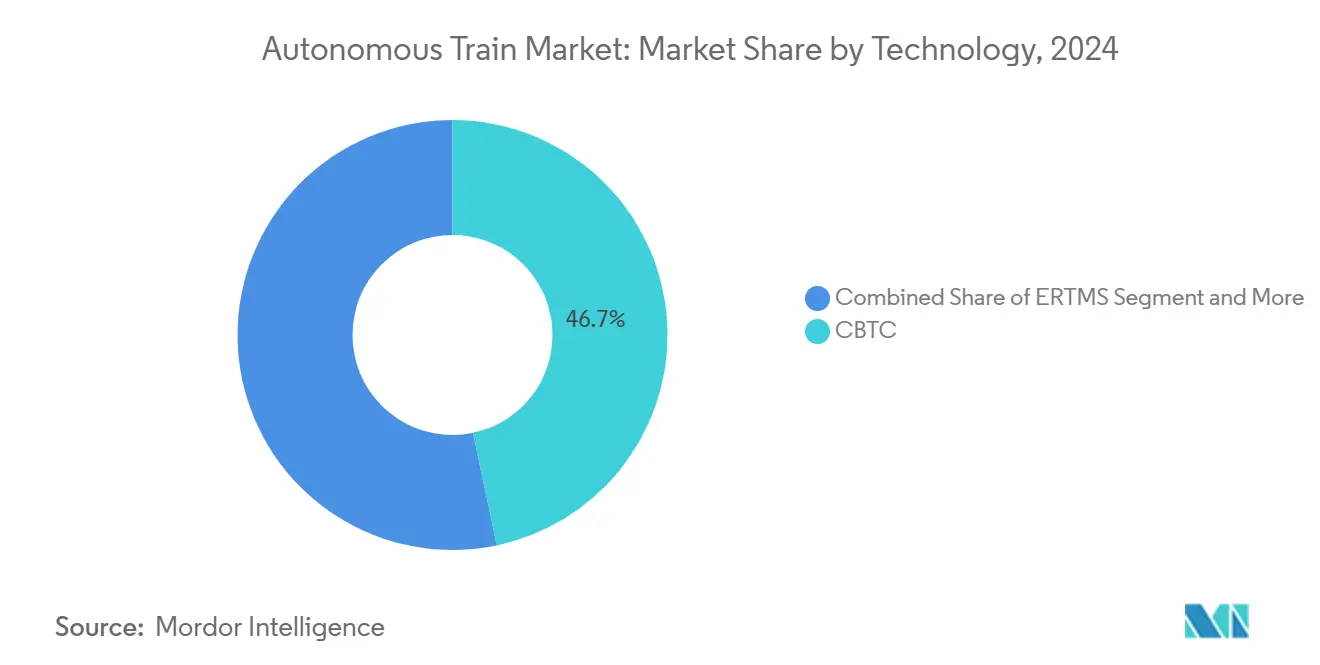
Note: Segment shares of all individual segments available upon report purchase
By Train Type: Metro Dominance Meets High-Speed Surge
Metro and monorail platforms represented 45.52% of the Autonomous Train market size in 2024, leveraging grade separation and uniform operating envelopes for seamless GoA 4 rollout. Light-rail programs experiment with partial automation where intersections permit. However, high-speed rail captures the top growth premium at 5.52% CAGR as nations modernize intercity corridors. The Siemens Mobility–led HS2 package brings Automatic Train Operation over ETCS L2 to Britain’s 360-kilometer-per-hour fleet, underscoring commercial readiness.
The Autonomous Train market size for high-speed corridors is poised to swell as Europe’s Automated Train consortium standardizes GoA 4 modules for >300 kilometer-per-hour services. Sensor fusion innovations allow braking-curve management at high velocities, allaying safety authorities’ concerns and clearing certification runways for future projects in Italy, Spain, and China.
Geography Analysis
Asia-Pacific captured 38.62% of the Autonomous Train market size in 2024, courtesy of China’s 66 operating UTO lines and fast-tracked extensions in India and Japan. CASCO Signal’s almost two-fifth domestic share displays China’s intent to localize critical automation technologies, while India’s Kavach automatic-braking platform is prepared for nationwide coverage across 34,000 kilometers, signaling sizable near-term procurement funnels. Japan leverages Shinkansen expertise to export consulting services, influencing global specifications for high-speed unattended operations.
Europe remains a heavyweight, integrating ERTMS-based automation across dense transnational corridors. Germany’s Digital Rail program, supported by Deutsche Bahn’s framework, and Network Rail’s Train Control Systems package illustrate structured investment strategies targeting system-wide migration. The European Union Agency for Railways coordinates ETCS-to-FRMCS timelines, ensuring interoperability at scale. The push bolsters equipment demand for certified radio blocks, onboard units, and safety-layer software.
The Middle East and Africa emerge as the fastest-expanding territory, charting a 5.43% CAGR to 2030. The UAE’s Etihad Rail Phase 2 commissions AI-enabled dispatch and predictive maintenance, while Riyadh Metro fields 67 Siemens Inspiro GoA 4 trains equipped with climate-optimized HVAC and automatic couplers. Sovereign diversification agendas pivot rail investments toward sustainable passenger mobility, accelerating schedule adherence to net-zero pledges. North America lags due to regulatory and labor complexity, but FRA exemptions for limited crewless tests in 2025 suggest gradual liberalization.
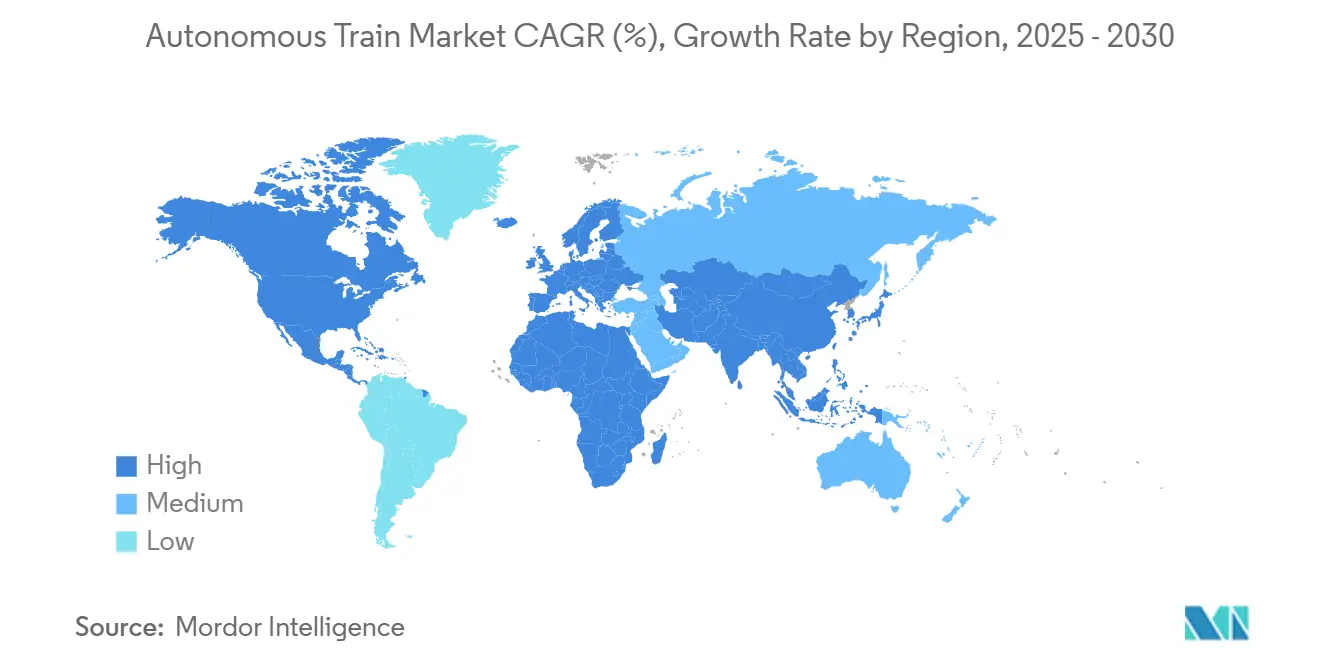
Competitive Landscape
The Autonomous Train market is moderately consolidated, with three top incumbents accounting for more than half of the 2024 contract volume. Siemens Mobility commanded strategic wins such as Deutsche Bahn’s digital-signaling modernization, consolidating its project-management and software leadership. Alstom secured a parallel Euro 2.8 billion (USD 3.26 billion) framework in Hamburg, strengthening its foothold in European ETCS rollouts[3]Alstom SA, “Hamburg Digital S-Bahn Contract Award,” alstom.com . Hitachi Rail differentiates via 5G-CBTC integration and AI-driven health analytics suites, carving a share in technologically advanced corridors.
Disruptors like Parallel Systems and Intramotev collectively raised over USD 50 million to pioneer battery-electric autonomous railcars, challenging locomotive-centric architectures and pursuing asset-light leasing models that bypass large-scale infrastructure retrofits[4]Parallel Systems, “Series B Funding Release,” parallelsystems.io . Certification barriers favor well-capitalized entrants that can absorb multi-year product-safety validation, intensifying funding races. Compliance with IEC 62443 cybersecurity and CENELEC TS 50701 functional-safety rules becomes a non-negotiable bid prerequisite, tilting the field toward suppliers offering end-to-end secure-by-design stacks.
The competitive playbook now revolves around platform ecosystems rather than discrete equipment bids. Winners offer modular reference architectures spanning onboard automation, wayside communications, and lifecycle software. Framework contracts shrink deployment cycles from eight years historically to under four years, enhancing incumbent revenue visibility while raising stakes for challengers that must scale quickly to defend valuations.
Autonomous Train Industry Leaders
-
Alstom SA
-
Thales Group
-
Siemens AG
-
CRCC Corporation Limited
-
Hitachi Rail STS
- *Disclaimer: Major Players sorted in no particular order
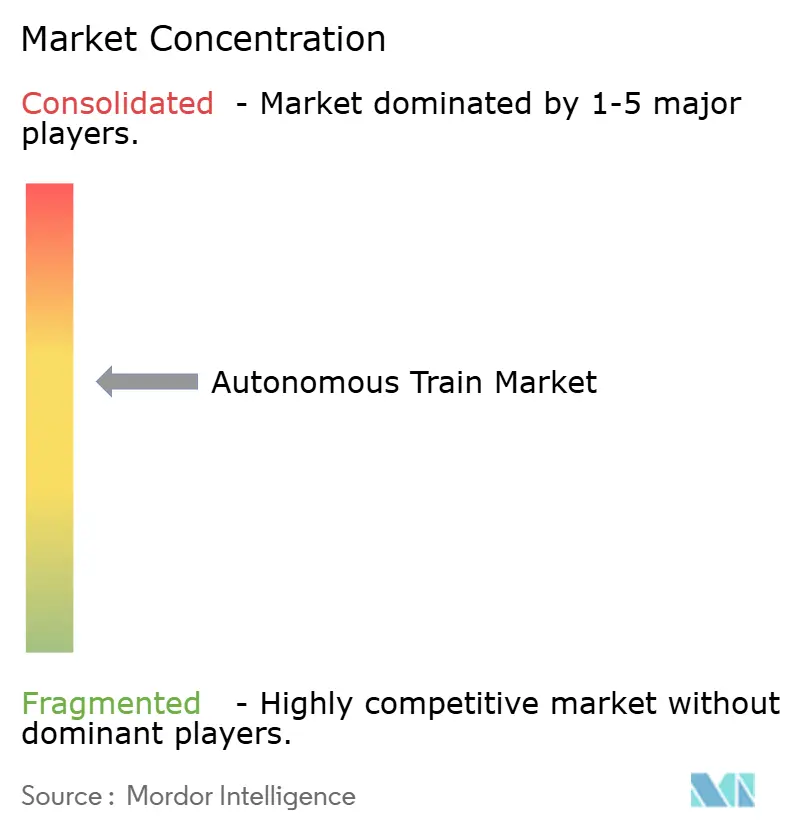
Recent Industry Developments
- August 2025: Alstom has secured a contract to supply 234 Metropolis metro cars and an advanced Communications-Based Train Control (CBTC) signalling system, along with five years of maintenance services, for Mumbai Metro Line 4.
- January 2025: Siemens Mobility secured contracts worth EUR 670 million for HS2, covering Automatic Train Operation over ETCS L2, high-voltage power, and telecommunications across a distance of 225 kilometers.
- January 2025: The Federal Railroad Administration has authorized Parallel Systems' crewless battery-electric rail vehicle pilot on the Georgia Central Railway, marking a first for freight transport in the United States.
- December 2024: Siemens Mobility, in collaboration with its partners, has successfully clinched significant rail contracts in Thailand, encompassing the acquisition of 53 state-of-the-art MRT trains for Bangkok. Additionally, these deals include vital upgrades to the signaling systems on the bustling Orange and Blue lines, ensuring seamless travel and enhanced safety for commuters through the year 2039.
Global Autonomous Train Market Report Scope
An autonomous train is a driverless train that operates without human intervention. Equipped with advanced technology, such as AI and sensors, it navigates, controls speed, and makes decisions on its own. Benefits include improved efficiency, safety, and capacity. However, safety standards and testing are crucial for public integration.
The autonomous train market is segmented by automation grade, application, technology, train type, and geography. By automation grade, the market is segmented by GoA 1, GoA 2, GoA 3, and GoA 4. By application, the market is segmented by passenger and freight. By technology, the market is segmented by CBTC, ERTMS, ATC, and PTC. By train type, the market is segmented into metro/monorail, light rail, and high-speed rail. By geography, the market is segmented by North America, Europe, Asia-Pacific, and Rest of the World.
The report covers the market size in value (USD) for all the above segments.
| GoA 1 |
| GoA 2 |
| GoA 3 |
| GoA 4 |
| Passenger |
| Freight |
| Communications-based Train Control (CBTC) |
| European Rail Traffic Management System (ERTMS) |
| Automatic Train Control (ATC) |
| Positive Train Control (PTC) |
| Metro / Monorail |
| Light Rail |
| High-speed Rail |
| North America | United States |
| Canada | |
| Rest of North America | |
| South America | Brazil |
| Argentina | |
| Rest of South America | |
| Europe | Germany |
| France | |
| United Kingdom | |
| Italy | |
| Spain | |
| Russia | |
| Rest of Europe | |
| Asia Pacific | China |
| Japan | |
| India | |
| South Korea | |
| Australia | |
| Rest of Asia-Pacific | |
| Middle East and Africa | United Arab Emirates |
| Saudi Arabia | |
| Turkey | |
| Egypt | |
| South Africa | |
| Rest of Middle East and Africa |
| By Automation Grade | GoA 1 | |
| GoA 2 | ||
| GoA 3 | ||
| GoA 4 | ||
| By Application | Passenger | |
| Freight | ||
| By Technology | Communications-based Train Control (CBTC) | |
| European Rail Traffic Management System (ERTMS) | ||
| Automatic Train Control (ATC) | ||
| Positive Train Control (PTC) | ||
| By Train Type | Metro / Monorail | |
| Light Rail | ||
| High-speed Rail | ||
| By Geography | North America | United States |
| Canada | ||
| Rest of North America | ||
| South America | Brazil | |
| Argentina | ||
| Rest of South America | ||
| Europe | Germany | |
| France | ||
| United Kingdom | ||
| Italy | ||
| Spain | ||
| Russia | ||
| Rest of Europe | ||
| Asia Pacific | China | |
| Japan | ||
| India | ||
| South Korea | ||
| Australia | ||
| Rest of Asia-Pacific | ||
| Middle East and Africa | United Arab Emirates | |
| Saudi Arabia | ||
| Turkey | ||
| Egypt | ||
| South Africa | ||
| Rest of Middle East and Africa | ||
Key Questions Answered in the Report
What is the 2025 valuation of the Autonomous Train market?
The Autonomous Train market size stands at USD 14.31 billion in 2025.
How fast is the market expected to grow during 2025-2030?
The sector projects a 5.37% CAGR, rising to USD 18.58 billion by 2030.
Which region leads current deployments?
Asia-Pacific holds 38.62% of global revenue, thanks to China’s extensive UTO program.
Which application segment is expanding quickest?
Freight automation is forecast to grow at a 5.45% CAGR as operators confront labor gaps.
What technology is set to dominate future installations?
5G-enabled CBTC, offering higher data throughput, shows the strongest 5.48% CAGR outlook.
What is the main barrier to wider adoption?
High initial investment, especially for retrofits, reduces near-term uptake in smaller networks.
Page last updated on:
